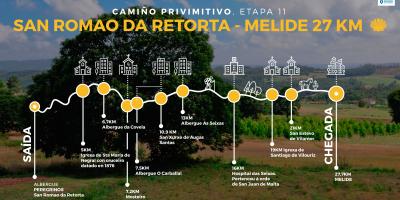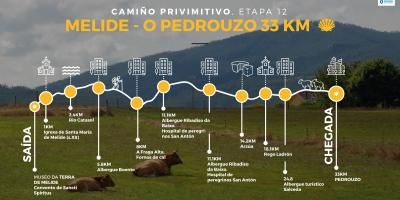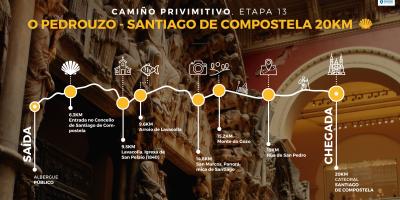The Primitive Way is the oldest known itinerary. It can not be understood without the personality of Don Afonso II de Asturias, who according to legend visited the tomb of St. James as soon as he was aware of it, an important fact in the emergence of the city of Compostela. Don Afonso III moved the capital of the Kingdom and obviously Oviedo lost weight on the road in contrast to the newer one: Leon. Hence the French Way soon overshadowed the Primitive Way.
The road in the province
In the province of A Coruña the Primitive Way runs through the municipalities of Toques, Melide, Arzúa, O Pino and Santiago de Compostela, being a slightly different path from the French Way, wich it joins to in the village of Melide.
The pilgrim can taste the gastronomy of inland Galicia, for instance, the octopus in Melide and Arzúa cheese wich have great importance. They are the two major towns of the Terras do Ulla e o Tambre, and as can be seen from its name, highlighted by their rivers, which significantly shape the contour.
Already in Santiago de Compostela city, regardless of everything that involves the spectacular Obradoiro Square, civil constructions stand out such as the Pazo de Baamonde and the Casa de Cabildo, communing perfectly with the cobbled Compostela streets. Pilgrims can also see other attractions, always in harmony with the context, as the Galician Center of Contemporary Art Museum, designed by the acclaimed architect Álvaro Siza, attached to modernity and with an eye on the reality of the city. Beside it, stands the whole involving the Convent of Santo Domingo de Bonaval and the park of the same name, which happens to be an oasis of tranquility, views and recreation.
More information on The Primitive Way, here
The path of the Primitive Way enters the province of A Coruña through the Serra do Careón, making the limit between the provinces of Lugo and A Coruña. It is a place with some ecological value that preserves flora and fauna almost disappeared in Galicia. The highest peak, called Careón, is 798m.
Melide is the town where Primitive Way meets the busiest French Way. In this locality you can visit the Ponte Leboreiro from the 14th century or medieval bridge from the 12th century. The churchs of San Martiño de Moldes, San Vicenzo de Vitriz, San Xoán de Furelos and the Pilgrims Hospital, now the Terra de Melide Museum, also highlight.
Already in Arzúa, we find the church of Santiago de Boente, and following the way we reach the Recreation Area of Ribadiso, with the pilgrims hostel that was an old medieval hospital.
After passing the town of Arzúa, in the village of Santa Irene we can see a chapel dedicated to the holy Portuguese martyr, built in the 18th century with the contributions of the nobles of the village of Dos Casas, and the fonte santa which has, according to tradition, healing properties for the skin.






